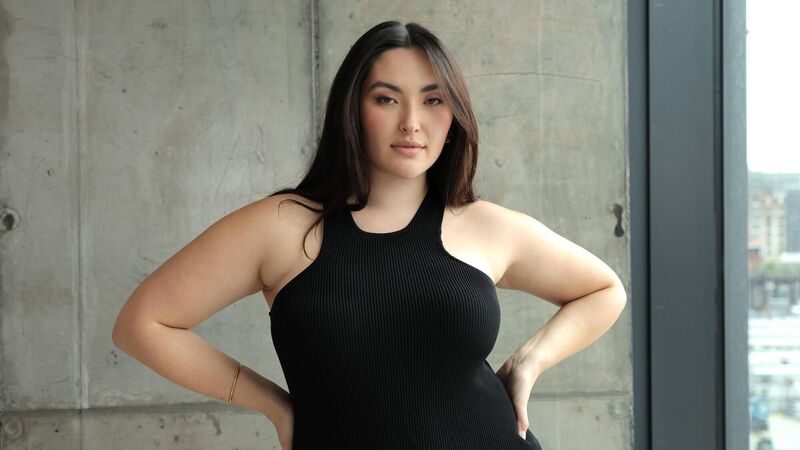Sarah Harte: Size acceptance should not come at the expense of physical health

Jordan Peterson drew criticism after stating plus-sized ‘Sports Illustrated’ model Yumi Nu was ‘not beautiful’. Picture: Mike Coppola/Getty Images
Over-indulgence during the festive season may have led to extra poundage. For some, this will translate into new year’s resolutions. Others won’t give a toss, and good luck to them.
Last month, when Kirstie Alley, the American actress famous for her role as Rebecca in the hit sitcom Cheers, died, The New York Times wrote that it was radical in the ‘80s and 9’0s for Alley to be “a fat, glamorous actress”. She spent years “as a tabloid punching bag” because of her weight, with “weight gain being seen as a moral failing”, and “weight loss as the only possible response”.
For those of us who grew up in Generation X, there was a point when thinness felt compulsory. In the 90s, we were bombarded with the heroin waif look which brought a whole generation of women into conflict with their bodies. Many of us shrank alongside the actresses from Friends.
The body positivity movement has meant that your weight is now theoretically your business. When controversial Canadian psychologist Jordan Peterson tweeted last year about a plus-sized Sports Illustrated model and musician Yumi Nu’s cover shoot for the magazine, writing: “Sorry. Not beautiful. And no amount of authoritarian tolerance is going to change that”, he was roundly castigated.
There still isn’t nearly enough body diversity reflected in fashion campaigns and on our screens. Articles written about the democratisation of fashion on foot of “bigger” models being used point to an underlying tokenism.
Standards of thinness held up as culturally desirable makes less sense than ever to the average woman who is now a size 14-16.
Obesity
And obesity is a growing problem. A Royal College of Surgeons study last year found that worrying levels of obesity and being overweight are seen at a very young age in Ireland, with 32% of five-year-olds being overweight or obese.
Ireland has one of the highest levels of obesity in Europe, with 60% of adults and over one in five children and young people living with being overweight or obese.
Multiple drivers influence obesity, including genetics as well as environmental and socioeconomic factors. Excess weight drives up to 65%-85% of type 2 diabetes and in 2022 Ireland was in the top 25% for diabetes incidence worldwide, although this figure is said to be stabilising.
Last year, in May, a report, presented at the European Congress on Obesity, revealed that obesity is among the leading causes of death and disability in the European region.
I’ve heard several parents speak of anxiety about broaching problematic weight gain with teenage daughters, specifically because of the risk of triggering eating disorders. And they’re right to be fearful.
Eating disorders skyrocketed among teens during the pandemic. According to the latest figures published last November by the Irish Health Research Board, the number of admissions related to eating disorders among children and adolescents continued to rise, with females accounting for 96% of psychiatric admissions.
Powerful cultural messages, along with personality traits and life experiences, cause eating disorders. Most women reading this article will know exactly how hypersensitive young females are to any insinuations about their weight.
Media treatment
Research clearly shows that media exposure contributes to body dissatisfaction and disordered eating, which is far more common than full-blown eating disorders. Unrealistic images and editing on social media have made a bad situation worse.
A recent headline in the New York Post ran: ‘Bye-bye booty: heroin chic is back’.
This headline encapsulates the idea that women’s bodies are viewed as trends while attempting to resurrect a body type that did so much damage to young women. It’s high time the media thought twice about running irresponsible, offensive headlines like this because frankly, it’s unacceptable.
In 2015, the French passed a law banning the use of models that are size zero, which is a UK size four — although this caused some exceptionally thin models to say they were being body-shamed.
Last year, a photo of a famous musician in a bikini on a magazine cover provoked commentary because she was clinically obese and possibly because she looked happy. Online she was both celebrated and reviled.
My thoughts were conflicted. They included “good for you”, which tells its own none-too-subtle story about my cultural conditioning — why should she need my patronising imprimatur?
The second was if I had a teenage daughter, I’m not sure that I would want her to internalise the message that it was desirable to be perilously obese any more than I would want her to decide that it was desirable to be size zero.
Is this not the supplantation of one unhealthy body archetype (ultra-thin) with a different one (clinically obese)? Or is it simply a woman being celebrated for being a different size, or simply a famous woman in a bikini?
In reality, it’s unlikely my fictive teenage daughter would internalise the message from one photo that being clinically obese was desirable, it’s hardly a bombardment.
Because “thin is better” remains the dominant message. It’s the baton of unhealthy body image that has been passed from generation to generation of women.
But when body sizes are increasing, the stage is set for an even bigger clash between the somatic reality of women’s actual real-life bodies and the default shape being presented as culturally desirable. Too fat, too thin — how are young women to make sense of this?
Our Obesity National Clinical Programme points out that obesity is “a highly stigmatised condition”. It says that negative attitudes to the overweight, even amongst healthcare professionals, lead to shame and slowness in seeking help.
Last year, Roisin Ingle in wrote powerfully about fat shaming. She wrote about being addressed as ‘Dear Fatty’ in an email written to her. She wrote, and she’s right: “I do not believe my body (or your body) whether bigger or smaller or anything in between is anybody else’s business.”
We have a problem with obesity in both males and females, but the plague of hating their bodies continues to be deeply, pathologically ingrained in women, which further complicates things for them.
Size-acceptance or size-inclusivity is crucial if women are ever going to attempt to have healthier relationships with their bodies, but health counts too.
Maybe we frame public discussions around weight on having functioning, healthy bodies and scrap words like ‘skinny’ and ‘obese’. After all, our lexicon around race has shifted in recognition of the fact that racism and language work together in important ways.
More generally, unless we address the ticking time bomb of obesity and diabetes, we’re looking at a full-blown public health emergency.

Subscribe to access all of the Irish Examiner.
Try unlimited access from only €1.50 a week
Already a subscriber? Sign in
CONNECT WITH US TODAY
Be the first to know the latest news and updates













